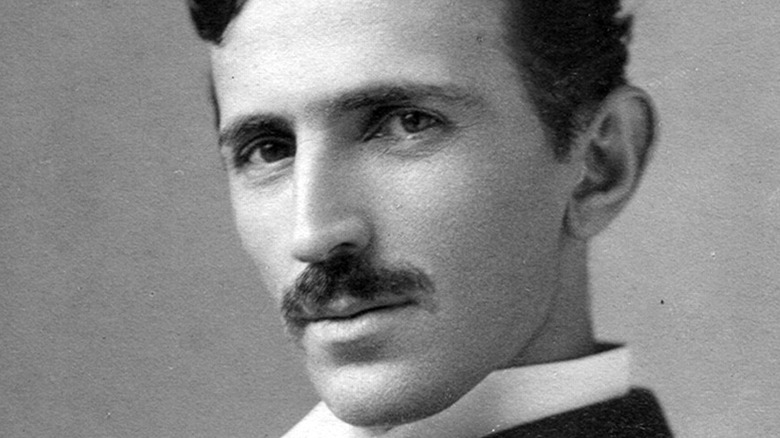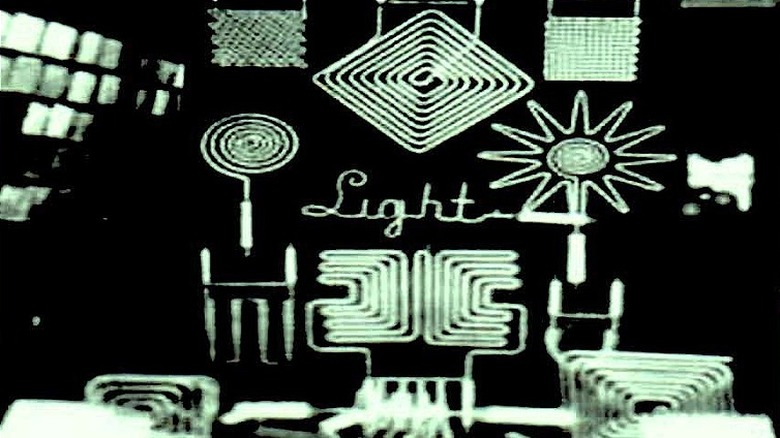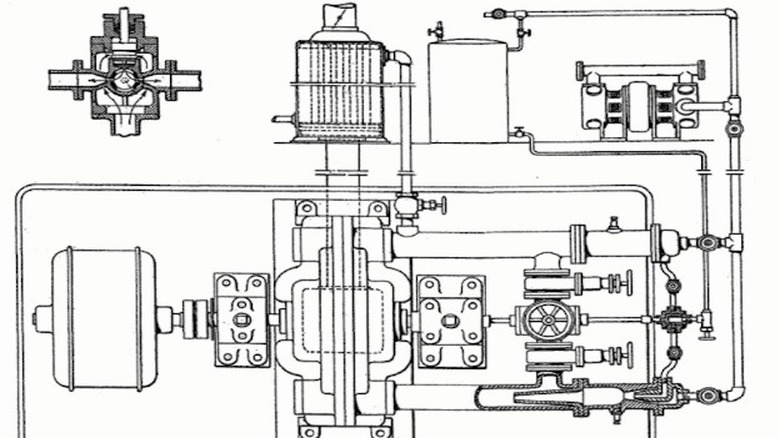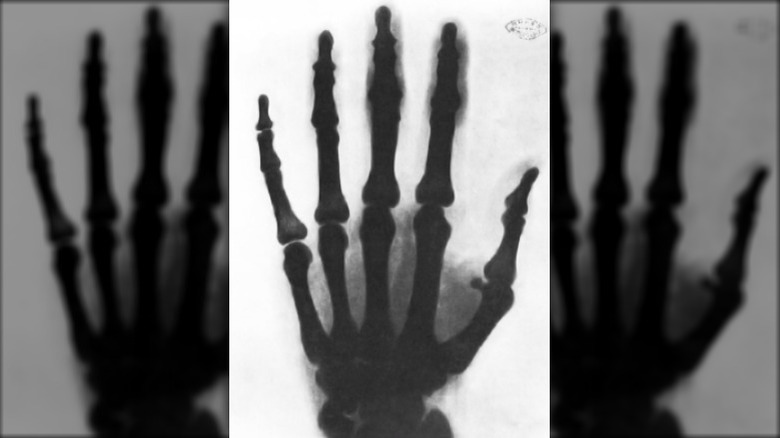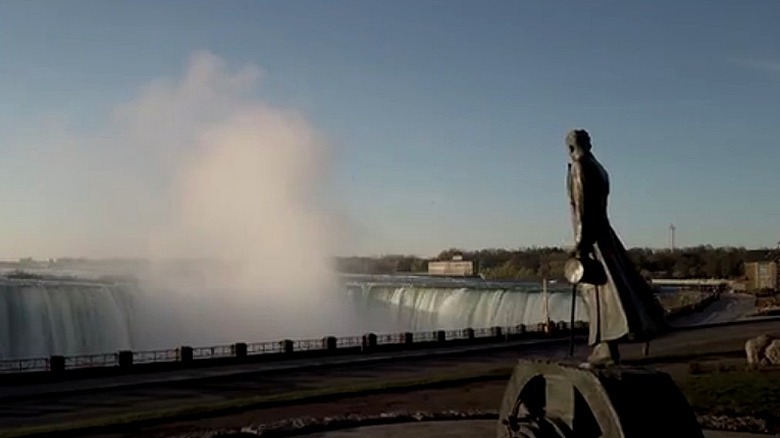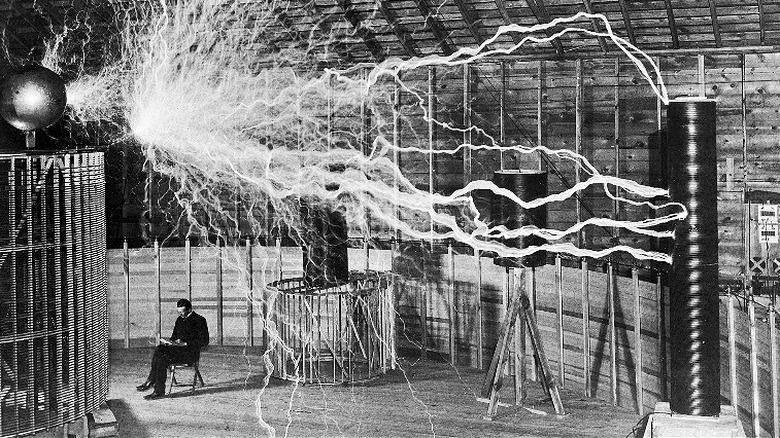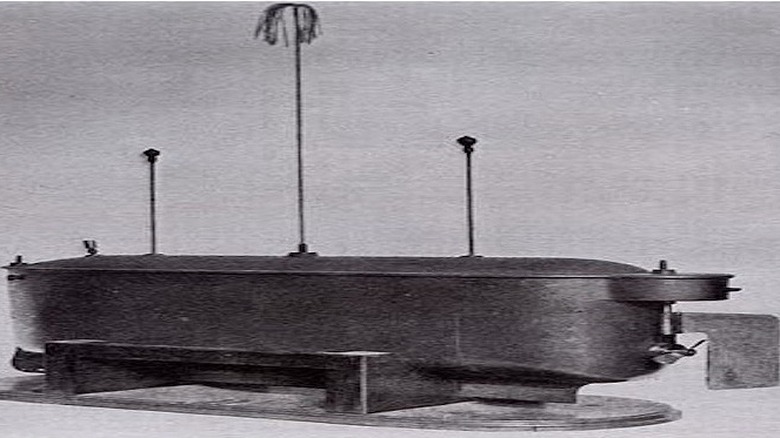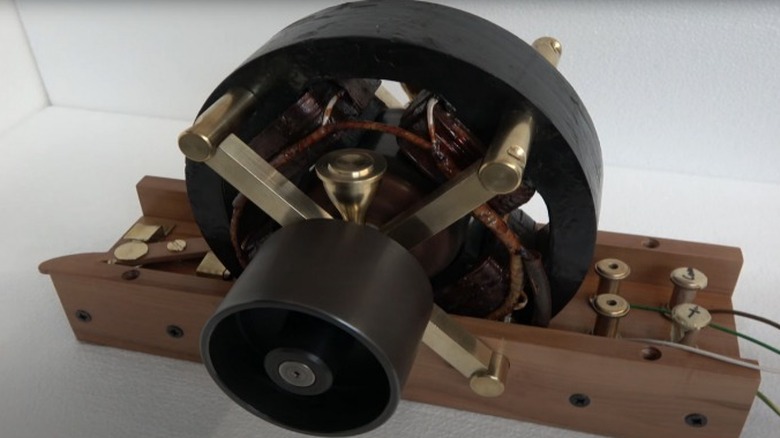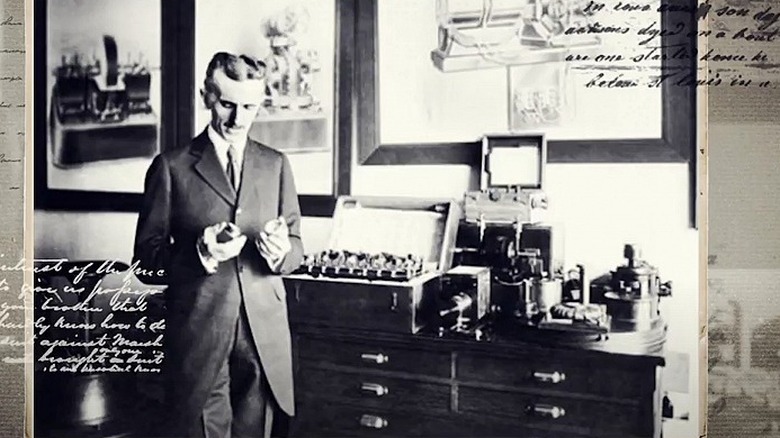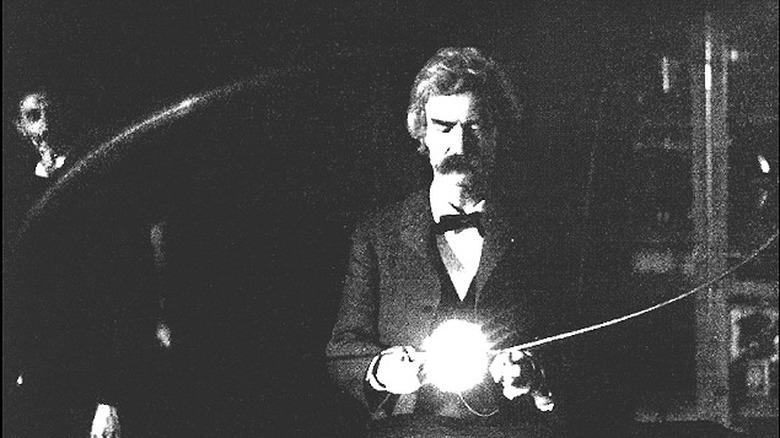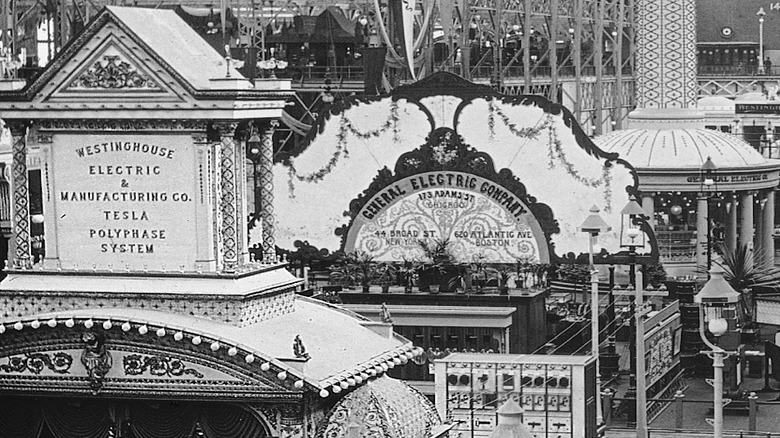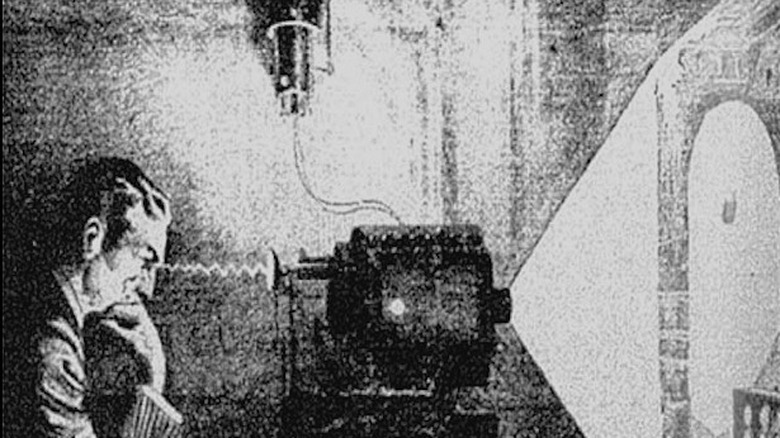10 Best Nikola Tesla Inventions
After dying penniless and nearly forgotten in 1943, the extraordinary Nikola Tesla now enjoys a permanent spot in the inventors hall of fame. Born in Serbia (now Croatia) in 1856, the eccentric, visionary Tesla is credited with some of modern history's most consequential inventions. As noted by "Tesla: Inventor of the Modern," entrepreneurs like Elon Musk and Google founder Larry Page regard Tesla as a folk hero as well as the father of electricity, radio, and robots. His name has become synonymous with innovation and genius. In addition to the airport in Belgrade and Musk's electric car company, notes Business Standard, units of measure in MRI scanners bear Tesla's name, and the coil he invented in 1891, still in use today, is called the Tesla coil.
Not surprisingly, the story of Tesla's inventions is as complex as the man himself. Attributing inventions can be tricky, as it's common for multiple inventors to be working on similar ideas simultaneously. Tesla, who immigrated to America at 28, held hundreds of patents, but his career was crippled in part when a fire in his New York laboratory destroyed much of his research, forcing him to file for patents late or to modify their applications. Financial setbacks also hampered his ability to finish projects. Consequently, in some cases, other inventors ended up receiving credit for inventions and breakthroughs Tesla completed first. Recent historical research, however, has led to a reassessment of Nikola Tesla and his inventions.
Phosphorescent lamps
As noted in "Tesla: Inventor of the Modern," in 1893, at the Columbian Exposition in Chicago, the world was introduced to Nikola Tesla, inventor, in spectacular fashion. Alongside a jaw-dropping demonstration of his most famous invention — AC electricity — was a presentation of Tesla's more modest creation, phosphorescent lamps. The display featured glowing phosphorescent tubes twisted into various words and shapes. One set read "Welcome, Electricians," while others offered tribute to legendary scientists Michael Faraday and Benjamin Franklin. Tesla even included a radiating shout-out to his favorite Serbian poet, Zmaj Jovan.
In his research, according to PBS, Tesla discovered that while electrified phosphorescent substances are slow to emit light compared to fluorescent ones, they glow longer after the juice is turned off. To test this principle in his laboratory, Tesla built electrified fields of phosphorescent tubes, which when turned off, continued to emit a ghostly green light, seemingly on their own. For the Columbian Exposition, Tesla added to his invention by shaping the glass tubes, creating the type of signage that would later be associated with neon.
While many sources credit Tesla as the inventor of neon lights, his phosphorescent lamps did not contain neon gas, which according to BBVA OpenMind, was not discovered until 1898; the first neon lamp didn't appear until the Paris Motor Show in 1910. However, Tesla does earn credit as the inventor of the first practical phosphorescent lamp.
Bladeless turbine
As explained in How Stuff Works, to create mechanical energy, engines require some form of liquid that will flow under an applied stress. Engines of the early 20th century applied stress on liquid either through pistons or bladed turbines. Piston engines were complex, heavy, and inefficient, and while bladed turbine engines had few moving parts, the blades required careful installation and tended to break and crack. Nikola Tesla, in fact, was inspired to create his bladeless turbine after seeing bushels of broken blades dumped from a turbine-equipped ocean liner.
Tesla's invention consisted of designs for three separate components — fluid propulsion, turbine, and valvular conduit — that when combined produced a highly efficient bladeless turbine. In a 1913 Patent Office application (via Tesla Universe), Tesla stated that his turbine would overcome the deficiencies of the bladed turbine by "propelling fluid to move in natural paths or stream lines of least resistance." To achieve these stream lines, as he noted in a 1911 New York Herald interview (via Rex Research), all that was needed was "some disks mounted on a shaft, spaced a little distance apart and cased so that the fluid can enter at one point and go out at another."
Tesla's turbine design was simple, but because it used centrifugal force, extra durable materials were needed for construction. Consequently, it was never put into commercial use. However, engineers today continue to experiment with it in the hope that its visionary technology can be exploited for greater energy efficiency.
The Shadowgraph
Who invented X-ray film? As noted in Wonderful Engineering, although Wilhelm Roentgen usually receives credit for producing the first X-ray in 1895, Nikola Tesla had been conducting similar research that same year. Documentation of Tesla's early X-ray testing was lost in the laboratory fire, but other writings reveal that just before Roentgen announced his invention in November 1895, Tesla, according to the Radiological Society of North America and History, had inadvertently produced the U.S.'s first X-ray image. Using a camera equipped with his newly developed unipolar X-ray vacuum tube, Tesla took a photo of visiting friend and technology-lover Mark Twain. To his surprise, instead of a portrait of Twain, he got an image filled with spots and splotches. Tesla assumed his tube had somehow damaged the photographic plate, but in reality, it had produced an X-ray image of one of the camera's screws.
After Roentgen published his findings, Tesla, connecting the dots, took X-ray images, or shadowgraphs as he dubbed them, of the human body, and sent them to Roentgen. While Tesla readily acknowledged Roentgen as the inventor of X-ray film, Roentgen conceded that Tesla's imaging was more advanced than his own. Tesla was also ahead of Roentgen in perceiving the medical applications of X-rays, describing how they could be used to detect foreign objects in the body as well as the presence of lung disease. In addition, Tesla understood before anyone else the potential health risks of excessive X-ray exposure and issued public warnings.
Hydroelectric power
According to PBS, in 1893, after a long and contentious search, the Niagara Falls Commission awarded Westinghouse Electric and, by extension Nikola Tesla, a contract to construct a powerhouse to harness the energy of the falls. As noted in "Tesla: Inventor of the Modern," Westinghouse bested the competition in large part because Edward Dean Adams, the project's lead engineer, and renowned British physicist Lord Kelvin, the commission's head, were fans of Tesla's AC electrical generator, the main component in Westinghouse's proposal for the powerhouse.
For his part, Tesla had long been fascinated by Niagara Falls. As a young boy in Serbia, Tesla had seen an engraving of the falls in his classroom and declared to his teacher that someday he would go to America and build a "big wheel" to capture the water's power. Although small-wheel technology was initially considered for the project, Adams eventually decided to divert water from the Niagara River through huge pipes that would feed into a series of turbines, which in turn would activate two of Tesla's giant AC-powered generators.
Construction of the powerhouse lasted three treacherous years. Finally, on November 6, 1896, the power switch in Niagara Falls was thrown, and 22 miles away in Buffalo, streetcars and streetlamps started lighting up. Soon, the Niagara powerhouse was illuminating New York City, 400 miles away. Tesla's hydroelectric generators had become the center of the world's first power plant, and he was honored with statues on both sides of the Falls.
Magnifying transmitter
As a man born during a raging thunderstorm, it should come as no surprise that Nikola Tesla was obsessed with the power of earthly discharges. As detailed in the Electrical Engineering Portal, after inventing his revolutionary coil, Tesla dreamed of using magnifying transmitters to create a wireless power system that would supply free energy to the world. While the Tesla coil was designed to discharge energy into the Earth, "the magnifying transmitter tuned to the natural resonant circuit of the Earth to create standing waves of electrical energy, which could be harnessed by a tuned receiving circuit." The circuit design required that "repeater stations" be set up globally, as "the strength of the signal is inversely proportional to the distance from the transmitter."
To realize his free energy dream, according to the U.S. Department of Energy, Tesla built a laboratory in Shoreham, Long Island, in 1901, with financial backing from J. Pierpont Morgan. At the laboratory, he then constructed two copper-domed, 185-foot towers — dubbed Wardenclyffe Tower — capable of firing 130-foot lightning bolts. According to the Tesla Science Center, using resonance, currents were transferred from one tower to the other until lightning sparked and discharged energy through a wire attached to the tower.
Although his magnifying transmitter succeeded in sending energy a kilometer away, the projected cost of building a global network of repeaters doomed the advancement of the technology. Nevertheless, today's wireless electric chargers owe their existence to Tesla's turn-of-the-century science.
Radio-controlled boat
In 1898, during the Electrical Exposition at Madison Square Garden, Nikola Tesla presented a demonstration of his latest invention, the teleautomaton. As noted in PBS, Tesla used radio signals channeled through a battery-powered remote control device — a small box with levers on the side — to guide a toy boat. According to "Tesla: Inventor of the Modern," the inventor envisioned teleautomatics (now known as robotics) as a way to control electromechanical devices wirelessly and from a distance.
At the Garden, as a rapt audience of scientists, investors, and the general public watched, Tesla launched his little boat in a small pool, using the remote control box to maneuver it back and forth and dance around in the water. Tesla even "asked" it what the cube root of 64 was, then flashed its lights four times in response. Some stunned spectators accused Tesla of using magic or telepathy to control the boat, and Tesla later wrote that his teleautomaton created a "sensation such as no other invention of mine has ever produced."
Although the invention was not exploited at the time, not even by the military, its technology was later used in drones and TV remotes and was instrumental in the development of robotics. When asked by a reporter about possible applications of the teleautomaton, the inventor prophetically declared, "You see there the first of a race of robots, mechanical men which will do the laborious work of the human race."
Induction motor
How to build an induction motor (via Explain That Stuff): First, construct a stator using a ring of electromagnets stacked together to produce a rotating magnetic field. Second, build a rotor out of a metal axle, a hamster wheel (sans hamster), and other metal pieces capable of conducting electricity. Third, place the rotor inside the stator and enjoy your induction motor!
When these simple alternating current motors were introduced to the world in 1888, they supercharged the engineering industry. According to PBS, the value of induction motors is in their ability to operate "without any moving electrical contacts and without first converting alternating current" to direct current. However, like the shadowgraph, credit for the induction motor has been the subject of much debate. Some believe that Nikola Tesla is the true inventor, while others award that distinction to Italian scientist Galileo Ferraris.
As noted in "Polyphase Electric Currents and Alternate Current Motors," Ferraris first conceived the idea of an induction motor in 1885 and first published his findings in March 1888. Tesla, according to "Tesla: Inventor of the Modern," hit upon his induction motor concept in 1882, while still living in Budapest. However, he didn't make his first design presentation until May 1888, two months after Ferraris, according to the World History Project. After a series of patent court cases, Tesla was officially named the inventor of the induction motor in 1905. Today, induction motors continue to power many of our household appliances.
Radio
Who created the radio star? Tesla! As noted in Live Science, radio, television, and mobile phone communication is derived from radio waves, which occur as electromagnetic radiation. Radio waves are measured by the frequency with which they pass through a fixed location, and when they're transmitted to a receiver, they're converted to "mechanical vibrations in the speaker to create sound waves." According to PBS, in the early 1890s, Nikola Tesla, using his new coil invention, discovered he could send and receive radio signals that were tuned to resonate at the same frequency, because "when a coil is tuned to a signal of a particular frequency, it literally magnifies the incoming electrical energy through resonant action." St. Louis reports that Tesla first publicly demonstrated a simple version of his invention at the 1893 National Electric Light Association Convention in St. Louis. By early 1895, he was preparing to send his radio waves 50 miles to West Point, New York.
Unfortunately, before the West Point demonstration, Tesla's radio design was destroyed in the same lab fire that claimed his shadowgraph plans, delaying the filing of his patent application. Tesla and the well-connected Italian inventor Guglielmo Marconi, who received the first wireless telegraphy patent in England in 1896, then began a long battle for U.S. patent rights. Although Marconi's radio design actually included an oscillator designed by Tesla, Marconi prevailed in patent court in 1904. However, in 1943, the Supreme Court upheld Tesla's patent, thereby posthumously awarding him radio invention bragging rights.
Tesla coil
More than any other of his inventions, the Tesla coil is the engineer's most recognizable invention. With its shooting tendrils of lights, the coil has become synonymous not only with the power of science but its madness and danger as well. The spectacle of its appearance is matched by the importance of its innovation. As noted by Live Science, with the invention of the coil in 1891, electricity was transmitted wirelessly for the first time. Radio antennas and telegraphs were the first devices to utilize the technology, but other applications soon followed.
According to PBS, each of the coil's individual components were known at the time, but the way in which Nikola Tesla modified and combined them was revolutionary. The basic Tesla coil "calls for a power supply, a large capacitor, the coil (transformer) itself, and adjustable spark-gap electrodes." When activated, the Tesla coil turns low-voltage, low-frequency electricity into high-voltage, high-frequency electricity. No wires involved.
According to "Tesla: Inventor of the Modern," over the years, Tesla patented 50 different versions of the coil, in different shapes and sizes, and used variations of it in numerous other inventions. His largest coil, according to PBS, built at his Colorado Springs lab in 1899, was 52 feet across. The (literal) flashiness of the coil, which he happily showed off at conventions and lectures, generated much publicity and was instrumental in making Tesla, at age 33, one of most talked about inventors of the day.
AC electrical system
Nikola Tesla's invention of the alternating current (AC) electrical system was undoubtedly his most significant, both in terms of social impact and scientific advancement. According to Britannica, alternating current is a "flow of electric charge that periodically reverses." First discovered by English scientist Michael Faraday, AC electricity, when harnessed, can transmit "power over large distances without great loss of energy due to resistance."
As noted by PBS, when Tesla arrived in New York City in 1884, incandescent lighting, as powered by Thomas Edison's power station, had been in use for several years. The station used direct current (DC), which had proven to be inefficient and dangerous. The youthful Tesla took a job with Edison, his idol, and suggested that the AC motor he was designing might be a safer, more efficient option than DC. Edison balked at the idea, and after a disagreement over money, Tesla quit Edison's company.
Later, with money from various backers, Tesla realized his AC power design dream, and in 1887, he filed seven patents for polyphase AC motors and power transmission. These accomplishments brought him to the attention of Edison's rival, George Westinghouse, who hired Tesla to devise a new form of long-distance power transmission. At that point, the War of the Currents, as it came to be called, began. Using publicity stunts and lawsuits, Edison attacked Westinghouse and AC for years. Eventually, AC emerged as the preferred method of electrical transmission, and continues to be used around the globe to this day.
Tesla's best also-rans
As noted in "Tesla: Inventor of the Modern," Nikola Tesla was a genius with an eidetic memory, but he also suffered from depression and obsessive flights of fancy. Existing on a few hours of sleep a night, he never stopped thinking about ways to improve the world and kept filing patent applications well into his 60s. Although his best inventions were transformational, not all of his ideas were practical or even technologically possible.
Among Tesla's problematic inventions was, according to History, an "earthquake machine," a vibrating steam-powered mechanical oscillator he built as an electricity generator. The device proved so powerful it caused his laboratory building to crack and shake, and Tesla quickly abandoned the project. His "thought camera" was probably his most bizarre idea. Convinced that "a definite image formed in thought must, by reflex action, produce a corresponding image on the retina," Tesla speculated that a "suitable apparatus" for projecting images of thoughts could be invented.
Tesla also developed plans for a wireless device that would detonate massive explosives at sea and cause tidal waves capable of sinking enemy fleets. His most infamous military invention, however, was his "death beam." Consisting of mercury particles accelerated at 48 times the speed of sound in a vacuum chamber, the beam was so intense, Tesla claimed, it could destroy fleets of planes 250 miles away. Although Tesla called it a "peace beam" and tried to sell it as a war deterrent, no country, save the Soviet Union, ever pursued its use.
